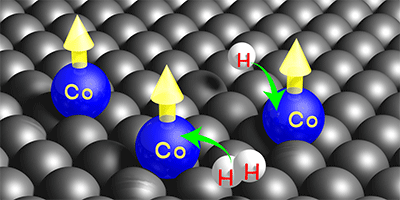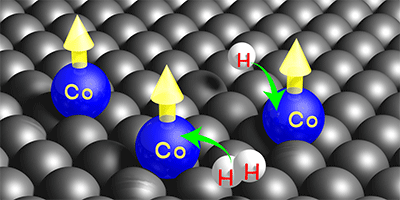Tunable Spin
Researchers are looking for new ways to control the spins of single atoms, which could be the building blocks for magnetic nanostructures and magnetic lattices. Fabio Donati and colleagues from Ecole Polytechnique Fédérale de Lausanne, Switzerland, have now shown that adsorbing hydrogen on single cobalt atoms changes their spin and their response to a magnetic field. Hydrogen has a low adsorption energy, so it should be possible to remove the hydrogen atoms, one by one, from the complexes using the tip of a scanning tunneling microscope (STM). This sort of reversibility would allow the spin-states in a lattice of the atoms to be “rewritten” multiple times.
The authors deposited cobalt atoms on a platinum surface, kept at K to prevent the atoms from diffusing or forming clusters. When the atoms are exposed to hydrogen gas, two complexes form: and . With an STM tip, Donati et al. measured the current that tunnels through the atom from the surface. This current depends on the size of the spin on the complexes, allowing Donati et al. to determine that CoH has a spin of and a spin of . These values are significantly higher than the measured spin of for bare cobalt atoms on platinum and the predicted spin of hydrogen-cobalt complexes that are unbound from a surface.
The unexpectedly high spins might, the authors speculate, be the result of the complexes hybridizing with the platinum surface: The interaction tends to bend the bond angles in the hydrogen-cobalt complexes, resulting a larger spin.
This research is published in Physical Review Letters.
–Katherine Wright





